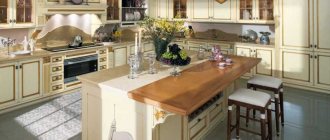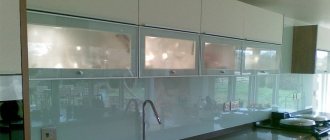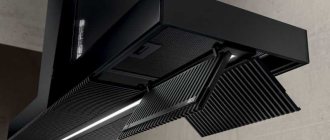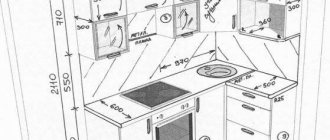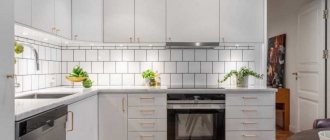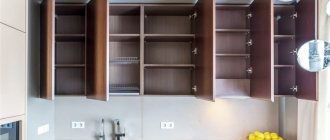Types of layout
Depending on the shape and size of the room, and the lifestyle of the household, you can choose one of six main options for planning a kitchen unit. We will consider below what methods exist for arranging furniture and equipment.
Straight (single row)
One of the most common and versatile options is to place furniture and appliances along one long wall.
A straight kitchen layout is preferable for rooms of 4-6 square meters, as it allows you to compactly organize the workspace and leave room for free movement.
For a narrow, elongated rectangular room, reminiscent of a carriage, a linear arrangement of furniture may be the only possible one.
Corner (L-shaped)
When it is impossible to arrange all three main zones along one wall, you can organize a corner or L-shaped layout.
It is also more convenient in terms of the work triangle.
The main problem of the L-shaped layout is the rational use of corner space. To make the most of every centimeter, choose a corner module equipped with a carousel with shelves or a pull-out section.
You will find more interesting options for arranging a corner kitchen here
U-shaped
The U-shaped layout is functional and spacious, but requires a large area for implementation.
But there may be exceptions here too. In a small kitchen, you can also make a U-shaped layout, but there will be no room left for a full-fledged dining area.
In this case, a small kitchen can only be a workroom for preparing food, and the dining room will have to be organized in the next room. In the kitchen, install a mini-stand for quick snacks or morning coffee.
With a U-shaped layout, it is necessary to take into account the distance in the aisles between cabinets - at least 1.2 meters. But this distance should also not be too large, so that you don’t have to walk a lot during the cooking process.
With island and peninsula
An island kitchen layout also requires space. It is impossible to install an island in a small or even medium-sized room.
Spacious kitchens in private homes are best suited for an island set, where it is easier to connect communications to the island and place a sink or hob on the island module.
In apartment buildings, an island arrangement of furniture is possible if the kitchen is combined with the living room, or if the apartment originally had an open layout. At the same time, it will not always be possible to connect communications, since the wet zone can legally only be moved along one wall. Ideas about building a podium under which communications will be hidden are troublesome and often involve a violation of the law. The best option in this case is to make the island an additional storage module and work surface.
You will find more fresh ideas for kitchen design fashionable in 2021 in our separate article.
An island or peninsula can serve as zoning in a kitchen-living room or studio.
Here you can organize a bar counter, which in a small apartment will serve as an independent dining area.
Parallel (double row)
This arrangement is ideal for rectangular rooms. But it is important to take into account the minimum recommended distance between rows of cabinets - 1.2 meters. Too large a distance is undesirable, since during the cooking process you will have to walk a long distance from one functional area to another.
To save space, one of the rows of cabinets with a parallel layout can be made smaller in depth - not the standard 60 cm, but, for example, 30 cm.
For the dining area, in this case there is space left at the end of the room, usually near the window, or between rows of cabinets.
With bar counter
The bar counter often acts as a single whole with the design of the kitchen unit. By extending the tabletop, you can create a bar counter under the window, connecting it to the window sill.
Or make a U-shaped layout from a corner layout.
In this case, the bar counter will serve as an additional work surface and perform a zoning function.
The bar counter can be equipped with an island or a peninsula.
Watch also a useful video on how to choose a layout:
Tips from designers
In the kitchen you need to create a triangle, at the vertices of which the sink, stove and work surface will be located. This is the most convenient placement from an ergonomic point of view.
A pass-through bar counter will help visually increase the space.
It is not necessary to create the island in the same colors as the rest of the kitchen. It can be several shades darker or even act as a contrasting element.
An island with a hob or sink needs good lighting. A decorative shelf above the island will complement it in design terms.
If there is nothing suitable in the store, you can always create a kitchen yourself using inexpensive materials like drywall and artificial stone.
Rules for proper planning
Before you start designing, it is useful to study recommendations for the placement of the main functional areas of any kitchen: refrigerator, stove and sink. This will help make the cooking process easier and faster.
Triangle rule
The main problem with planning a kitchen set configuration is not knowing where to start. In this case, the working triangle rule will always help, which gives an understanding of the proper distribution of the main zones:
- storage areas (includes refrigerator and food cabinets);
- areas for preparing food for cooking (represented by a sink and part of the work surface);
- cooking area (hob, oven, microwave, cabinets for storing dishes and cooking utensils).
Depending on the shape of the room and the layout of the set, you can choose several ways of the relative arrangement of these three zones. Possible options are presented in the picture below.
Working triangle rule for linear, corner, U-shaped, island layout
The working triangle rule was derived from the idea of the sequence of the technological process of cooking. It is designed to make moving between zones as comfortable as possible and, as far as possible, less costly in terms of time and effort.
Does the work triangle rule always work? We recommend that you follow it as a RULE, but not as a LAW. There are times when it is necessary to retreat from it. This often happens due to the location of communications and when planning a set for a very small kitchen of 4-5 sq.m., or for a room of a non-standard shape, with architectural features.
But, even if you had to deviate from the rule of the working triangle, one thing always remains relevant:
The presence of buffer zones between the three main zones is mandatory!
Minimum recommended distances
There should be some distance between the refrigerator, stove and sink, a work surface, so that you can put food from the refrigerator or cabinet somewhere and prepare it for subsequent heat treatment.
- Between the refrigerator and the sink - at least 60 cm.
- Between the sink and the stove - at least 60 cm.
- Equipment cannot be placed close to each other. This is fraught with disruption of its work. If the refrigerator and oven are located next to each other, then they should be separated by at least a small module 15-20 cm wide;
- You should not place the sink close to the wall so that you do not have to constantly wipe up splashes. It is recommended to retreat 10-15 centimeters. If the sink has a wing, then this distance can be occupied by the wing.
- Between the hood and the work surface - 55-65 cm for an electric stove and 70-80 for a gas stove.
- Between the refrigerator and the wall - at least 7 cm.
- Sockets in the work area and behind cabinets should not be located near the sink.
In a small kitchen, it is not always possible to follow the distance recommendations listed above. You can move the sink closer to the refrigerator, but (!) not to the stove. There should always be a distance between the hob and the sink equal to the minimum working surface - 60 cm.
The correct working triangle using the example of a small kitchen
Too large distances between the three main zones are also undesirable. The recommended maximum is 2.5-3 meters.
Where to put the refrigerator?
The question of where to put the refrigerator is most often asked by owners of apartments with a small kitchen, or when it is impossible to comply with the working triangle rule for some reason. The problem lies in the dimensions of the refrigerator itself. How to find the best place for it in different conditions? Below are some possible locations:
- In the corner near the wall, to the left or right of the unit - a classic option that allows you to harmoniously fit the refrigerator into the interior of any size.
- Near the window, unless it blocks the light. This arrangement option can often be found in Khrushchev-era kitchens.
- In a niche formed after redevelopment. Again, this is the most typical situation for Khrushchev houses, in which the entrance to the kitchen was moved into the room, and a niche was formed in the place of the former corridor.
- Separate from the kitchen unit on the opposite wall. This option is possible when the wall is not long enough to place furniture and a refrigerator in one row. Or when the refrigerator is a bright accent in the interior and needs to be highlighted. This location is also relevant for side-by-side refrigerators.
- Take the refrigerator out into the hallway/closet/room. This is inconvenient, but may become a necessary measure. For example, when the kitchen is so small that the refrigerator simply does not fit in it under any circumstances.
Built-in refrigerators look most harmonious in the interior. The exception is bright, colored equipment, which does not need to be hidden behind a facade.
If you need to fit in a freestanding refrigerator, then it is better to do this using one of the methods suggested below:
- Choose a refrigerator and facades of the same shade. For example, a white refrigerator and white facades.
- Build a refrigerator into a niche of kitchen cabinets. To do this, even at the design stage it is necessary to provide a cabinet above the refrigerator. It is better in this case if the set is located under the ceiling.
- Close the freestanding refrigerator in the closet. The difficulty is to find a cabinet suitable for the size of the refrigerator, taking into account the margin between the wall and the refrigerator of 7 cm on each side.
Do not place the refrigerator close to the wall or stove. The equipment must remove heat during operation. Violation of this requirement will result in failures and breakdowns. We have already given the recommended distances between the refrigerator and the wall/stove in the paragraph above.
Passage width
To make movement between the main areas of the kitchen convenient, take into account the minimum requirements for the width of aisles when designing:
- between low furniture for the passage of one person - at least 60 cm, for two - from 90 cm;
- between high furniture and the wall - at least 90 cm (for one) and from 120 cm (for two).
Also allow distance for opening the interior door (if there is one) and for opening cabinet doors. In order to save space in a small kitchen, it is more advisable to install sliding rather than hinged interior doors.
Using ledges and niches
Niches and protrusions are more commonly considered a disadvantage of the interior. Indeed, in this case there will be more hassle with designing a kitchen, especially if the niche or ledge is located directly in the area where the furniture is installed and divides the wall into 2 parts. But there are several tricks on how to turn these design flaws into advantages.
Niche solutions
- Equip a niche for a built-in wardrobe. And these are additional storage spaces that are never superfluous.
- If you cannot install a built-in wardrobe in a niche, you can always cover it with plasterboard.
Overhang Solutions
- Go around the ledge with the headset.
There are fewer problems if the ledge is in the corner.
If the size and shape of the room allow, then you can install a linear layout and then the protrusion ceases to matter. In the case of an L-shaped layout, or when the protrusion is in the middle of the wall, it is necessary to adjust and cut out part of the module for it.
If the width of the overhang is equal or almost equal to the depth of the kitchen cabinets, then you can not cut anything, but simply place the kitchen on both sides of the overhang, as shown in the photo below.
- Build on top, level the wall with plasterboard. In this case there will be pros and cons. On the one hand, a flat wall does not create problems with the selection and installation of kitchen units, on the other hand, centimeters are lost, which are never superfluous in a small room.
You can build on not only the wall to the right or left of the ledge, but also the ledge itself. For example, when you need to bring it to the depths of cabinets in order to dock with them. This solution is often used to install an L-shaped set.
- In the upper part of the set, the box can be made the main accent, highlighted with an interesting apron, or disguised, surrounded by shelves or leveled in the upper cabinets in one row.
Kitchen projects with arrangement
In order to visualize the arrangement of furniture in your own kitchen in one form or another, look at what ready-made kitchen projects look like.
Which layout should you choose?
When choosing a layout, you have to take into account, first of all, the location of communications - water supplies, sewer drains. But this is not the only thing that will affect the configuration of kitchen furniture. To choose a layout, it is important to take into account not only the architectural features of the room, but also the living conditions and lifestyle of the household:
- what is the composition and size of your family?
- How much time do you or your household spend in the kitchen?
- Is everyone used to gathering together at the dinner table? Or is everyone used to having lunch/dinner in their own room?
The answers to these questions will give you a clear understanding of what exactly you need.
For example, if the family likes to get together for lunch or dinner as a whole, then a large dining table is needed, and, therefore, this needs to be coordinated with the dimensions of other furniture, especially in a small kitchen, where it is not so easy to allocate space for a full-fledged dining area.
If you often cook a lot for a large family, then in a small kitchen it is possible to implement a U-shaped layout, but in this case the dining area will most likely have to be moved outside of it and a dining room can be organized in the adjoining room.
This may also be interesting: Three secrets of a comfortable and practical kitchen.
Based on the shape and size of the room
To summarize, we summarize all of the above into brief instructions in the form of a table.
| Dimensions and shape of the room | Optimal layout option |
| Small kitchen 4-6 sq m | Linear or angular |
| Square room | Corner |
| Rectangular, narrow and elongated | Linear or parallel |
| Large kitchen-living room or studio | Any layout will do, but often the most successful layout is island, peninsula, or U-shaped. |
| Irregularly shaped, with extra corners | Linear, double row |
Kitchen set in bay window
Taking into account the number and size of cabinets, the headset
When choosing a kitchen layout, you should take into account the lifestyle and real needs of the family. For one or two people, a small, compact corner or straight set may be sufficient.
For a large family that is used to having breakfast, lunch and dinner at home, you will need a spacious kitchen set with plenty of cabinets. In a spacious room there will be no problems with fitting everything you need if you choose a corner, island or U-shaped layout.
If the room is small, but you need to fit a large set of appliances and kitchen utensils, you need to make good use of every centimeter:
- install upper cabinets to the ceiling. They can be used to store things that are rarely used;
- use tall column cabinets;
- rationally use corner modules by installing the “magic corner” system;
- use the kitchen basement for storage;
- Properly organize storage inside cabinets using special organizers.
If there are 2 windows or access to a balcony
A room with windows on both sides has the advantage of good natural light. But at the same time, it is problematic to arrange kitchen furniture in a standard way.
In this case, you can implement almost any layout, but at the same time partially abandon the upper cabinets.
You can compensate for storage using tall column cabinets installed in the corner. The main thing is not to block the window.
The space under the windows can be used as a work surface by removing the window sill, or the sink can be placed opposite the window.
Option 2. Window sill-table top
The space under the window is great not only for washing, but also for arranging a food preparation area. The advantages are still the same - pleasant natural light, views from the window, space saving, and the ability to create additional storage space. However, unlike a window sill-sink, a window sill-tabletop is easier to organize, since there is no need to draw water lines to it.
Corner kitchen with a window in a Khrushchev-era building converted into a studio
Kitchen design with a window in the middle
- Ideally, the food preparation area should be located in the middle between the sink and the stove. If this is not possible, then it is more convenient to place the sink closer to the window sill rather than the stove.
- Remember that in order to avoid fogging up the windows and the appearance of mold, it is necessary to provide a small grille in the countertop to allow air to pass from the radiator to the window.
Kitchen zoning
When planning your kitchen, it is important to use zoning techniques. They can change the perception of space, helping to create coziness and a comfortable environment.
You can visually separate the kitchen work area from the dining area using lighting, color, wall finishing materials, etc.
Zoning elements are often partitions made of plasterboard, glass or wooden slats.
In a large kitchen or kitchen-living room, the current method of zoning is a peninsula, island, bar counter or sofa installed with the back to the set.
Photo in a small kitchen
In modern design, there are mini-modules that provide economical and efficient use of space. In addition, a narrow peninsula is often chosen for a small room.
The photo shows a narrow island in a small country-style kitchen.
Mobile products equipped with wheels are perfect for a small room. In an elongated space, the island resembles a bar counter and is used as a partition.
The photo shows a small-sized kitchen, complemented by a rectangular island with rounded corners.
Features of the kitchen-living room layout
When choosing the layout of a kitchen-living room set, there will be some zoning nuances, since in addition to the kitchen and dining room, there is also a living room. At the design stage, you should immediately take into account all these three zones in order to correctly arrange the furniture.
- When choosing a place to install the unit in the kitchen-living room, you should first of all be guided by the communications connections (water, sewer). Choose a layout and start arranging cabinets, starting from the location of the sink and refrigerator.
- For the dining area, plan the space based on your lifestyle, composition and size of your family. This could be a compact bar counter in a small studio or a long dining table for a large family.
- The sofa can be installed opposite the kitchen unit against the wall or with its back facing it. There are also options for perpendicular placement.
Don’t be afraid to deviate from the standard arrangement of furniture – around the perimeter. A dining area or sofa can be installed in the middle of the room to zone the space.
Read all about the design of the kitchen-living room in a separate article - go.
Pros and cons of an island in the kitchen
Installing an island, of course, hides the kitchen space, but the benefits from it are significant:
- Ergonomics. So, its presence greatly speeds up the cooking process, since it is much more convenient to move around the kitchen and carry out manipulations. The island can become a convenient table at which food is prepared or several people are simply seated for a conversation.
- High degree of functionality. An island element in the kitchen can even replace part of the kitchen unit. It can contain a hob and oven, a sink, a refrigerator, a wine rack, a countertop that acts as a work area, a bar counter, a dining table, and storage space for dishes and related accessories.
- Possibility of using the island as a dining area. If there is no need to create a separate dining area, then an island element in the kitchen is perfect for seating the family at lunch.
- Wide range of execution possibilities and stylistic orientation. For a kitchen with any design, you can easily choose the optimal island that will make it stylish and impressive.
- Kitchen zoning. Using this detail, you can separate the kitchen from the living room or dining room.

